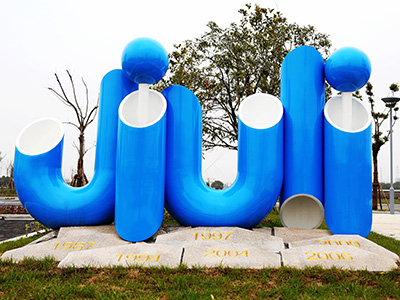Austenitic stainless steel in high temperature and room temperature shall be austenitic organization, organization transformation, not as a result, austenitic stainless steel is also a kind of can't through the heat treatment to make the steel reinforcement of stainless steel, but because of the austenitic stainless steel is easy to cold work hardening, austenitic stainless steel, therefore, may through the cold work hardening deformation (cold) to improve its strength. The low solid solution strength of such steels was once a major weakness of austenitic stainless steels.
In order to solve the sensitized intergranular corrosion of austenitic stainless steel and improve the corrosion resistance of steel, the amount of carbon in ultra-low carbon austenitic stainless steel is generally less than 0.03%, and the strength of steel is reduced while the corrosion resistance is improved. Since the 1970 s, charged with nitrogen (within the scope of the standard residual nitrogen content in steel, such as N or N acuities were 0.10% and 0.12% or less) or add nitrogen alloying (under normal pressure, the maximum number of nitrogen to join in steel, such as 0.40% or 0.50% or higher) or less, the emergence of austenitic stainless steel by adding nitrogen in solid solution strengthening, also can obtain very high strength, but by high pressure nitrogen, obtained high nitrogen (available nitrogen under pressure, that is, N > 0.4% or 0.5%) austenitic stainless steel, more can obtain very high strength and good fracture toughness. The combination of nitrogen solution strengthening and cold hardening makes some austenitic stainless steels join the ranks of high strength stainless steels.
Cr-Ni austenitic stainless steel is the existing five kinds of stainless steel in the best comprehensive performance, the most grades, varieties, specifications of the most complete, the most wide range of application, the fastest development, the largest output, the widest consumption field of a class of stainless steel. In the world and in the main stainless steel producing countries, chromium-nickel austenitic stainless steel generally accounts for more than 50%~60% of the total production of stainless steel.
Nickel is a scarce and expensive element, especially in wartime. In the 1940s, standard chromium-manganese austenitic stainless steel (American AISI200 series steel), which replaces nickel with manganese and nitrogen, was developed for a long time, but its use was narrow and its output was low. The annual output in the United States accounted for several percent of the total output of stainless steel, and about 1% of the total output in Europe. In recent years, especially the emergence of high nitrogen and high strength, ultra-high strength Cr-Mn austenitic stainless steels and the progress made in the research of high nitrogen and Mn free austenitic stainless steels have attracted extensive attention.
The development of austenitic stainless steels is shown in Figure 1 below.

In order to solve the intergranular corrosion of Cr-Ni austenitic stainless steel after welding, since the emergence of ultra-low carbon (≤0.03%) stainless steel, so far the development of Cr-Ni austenitic stainless steel solubility decline, so high nickel content and some special grades, also requires the steel carbon content is lower (C≤0.01% or C≤0.02%)
Nitrogen, as an important element, has been widely used. In recent years, almost all Cr-Ni austenitic stainless steels developed contain nitrogen, and the nitrogen content of some brands has reached the limit level of nitrogen solution in austenitic steels at atmospheric pressure. The addition of nitrogen reduces the sensitivity of high chromium and molybdenum austenitic stainless steels to microstructure thermal stability, and 6%Mo type and 7%Mo type super austenitic stainless steels appear. The wide application of nitrogen fully shows that nitrogen is very beneficial in Cr-Ni austenitic stainless steels and the advantages far outweigh the disadvantages. Nitrogen containing austenitic stainless steels became modern austenitic stainless steels.
In order to improve the corrosion resistance of austenitic stainless steel, the content of chromium and molybdenum in steel is increasing, especially with the advent of super austenitic stainless steel, the molybdenum content in steel has reached nearly 8% level; The chromium content has also increased from 25% in the past to nearly 28%, or even as high as 33%. In order to obtain a single, stable austenite structure, the nickel content of steel with chromium content ≥28% is about 31%, which has actually entered the ranks of Fe-Ni based corrosion resistant alloys. The advent of super austenitic stainless steels also fills the decades-old gap between stainless steels and high nickel corrosion resistant alloys in which there is no high corrosion resistance stainless steels.
In order to meet the needs of some special and special purposes, there are many special stainless steel, such as nuclear grade (NG) stainless steel, urea grade (UG) stainless steel, nitric steel and high temperature strong oxidizing acid medium with stainless steel. (From Introduction to Stainless Steel)


















